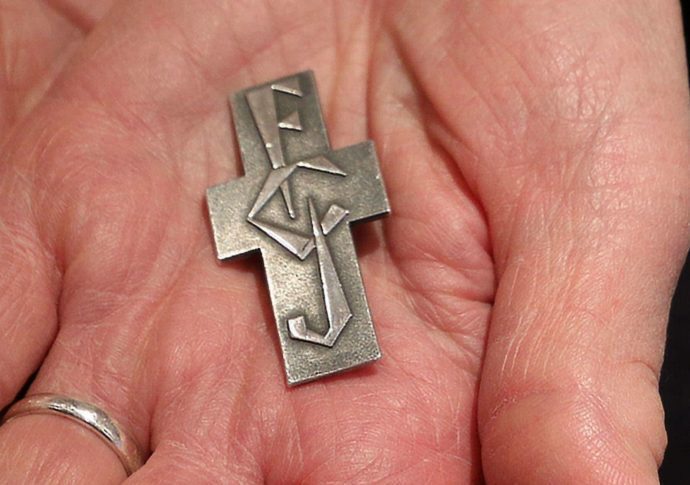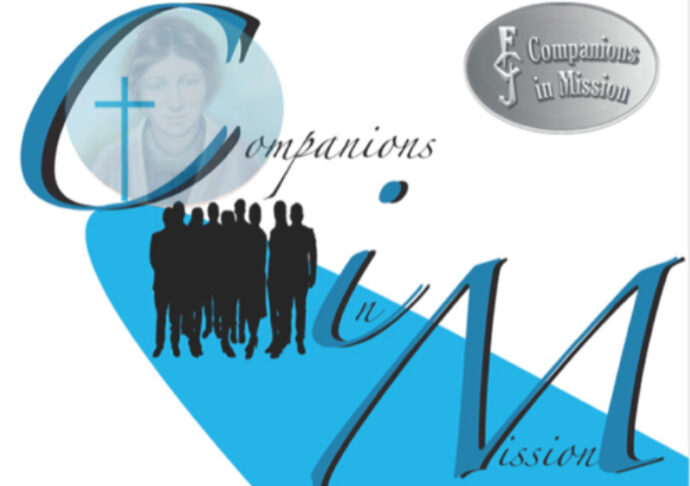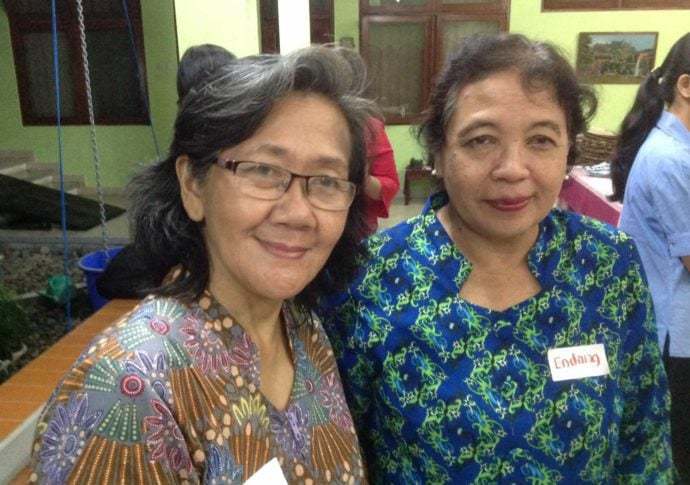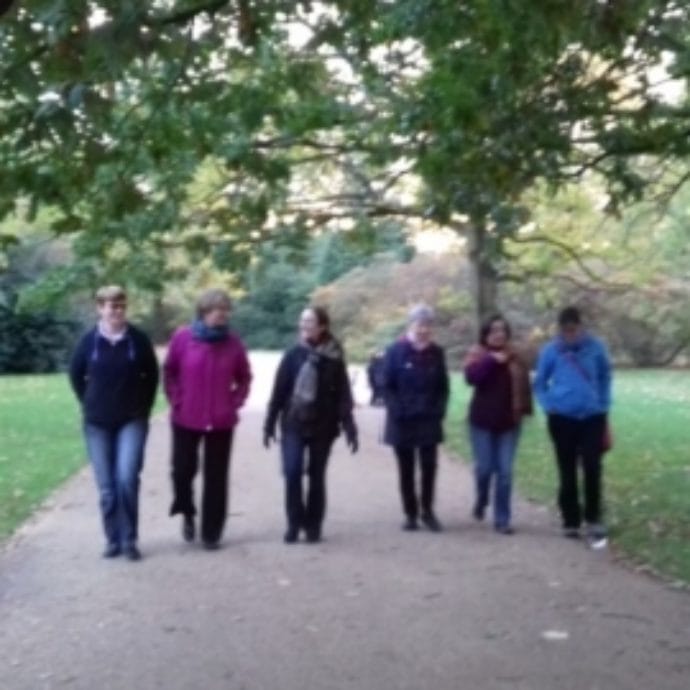By Teresa White fcJ, first published in The Way, an international journal of contemporary Christian spirituality, published by the British Jesuits.
The members of my religious congregation, the Faithful Companions of Jesus, have always had a special interest in the town of Amiens in Northern France. It was in Amiens in 1820 that our Founder, Marie Madeleine d’Houët, after much prayer, and having risen above not a few difficulties with the Jesuits of Saint Acheul College (on the outskirts of the city) who were guiding her, reached the point of starting the work she felt called by God to do: she opened the doors of her first little school on the corner of Rue des Augustins and Rue Dupuis. The house where she and her early companions lived, and where they taught the poor children who were their first pupils, is in the shadow of Amiens Cathedral. Last summer, I spent a week in that house with another sister, and we had the opportunity to absorb something of what Gerard Manley Hopkins calls the ‘air things wear’ in that special place. Each day, on our way to morning Mass in the cathedral, we walked along the cobbled streets that Marie Madeleine had walked two hundred years ago with the same destination in mind. As we entered that truly amazing edifice, I for one came under its spell.
Summer is the season when millions of tourists, in Europe and elsewhere, choose to walk on the holy ground of historic churches and cathedrals. In France, where usually there is no entrance fee, they can do it for free – the inevitable queues are not for tickets but for security checks. The sanctity of a holy place ‘shall not depart from it’, says T. S. Eliot (Murder in the Cathedral), in spite of the influx of ‘sightseers with guide-books looking over it’. I was reminded of this during those daily visits to the cathedral in Amiens, when tourists with guide-books were certainly not lacking, even though many of those who visit it today probably do not share the faith of those who built it. One rainy day, and there was only one, I was moved to look up a few of the historical details. Amiens Cathedral was begun in 1220, and such was the prosperity of this town of woad-dyers and cloth-merchants, that the building was completed within a mere seventy years (the far more famous Notre Dame de Paris took two hundred), in 1288. During those days, I became aware that there is a tranquil stability about this cathedral, so that, although massive – it is the largest Gothic cathedral in France – the structure feels light and balanced. For me, Notre Dame d’Amiens shares that sense of blessing that Eliot experienced in Canterbury; it is one of those timeless ‘holy places’ in which the proximity of God is perceptible.
Is it possible to label a whole era using a single word? In France, I’ve heard it done, tongue in cheek, in a succession of rhyming words: the essence of the High Middle Ages, for example, is encapsulated by ‘Faith’, la Foi. In the 15th and 16th centuries came the Renaissance – a time of reawakening, enthusiasm, exploration, discovery – impossible to sum up in a single word, even for the French! There was no problem with the 17th century word, though: it had to be le Roi, for in France at that time, the Sun King, Louis XIV, was seen and expected to be seen as the centre of the public life of the nation, his importance duly and grandly expressed in the arts, in architecture and literature. In the 18th century, the Age of Enlightenment, the word law, la Loi, expressed something of the certainties generated by the deliberate use of reason and scientific method advocated by the philosophers of the period. For the 19th century, with the flowering of Romanticism and its emphasis on emotion and individualism, what more appropriate sobriquet could there be than le Moi: ‘Me’ or ‘Myself’? La Foi, le Roi, la Loi, le Moi – I haven’t yet heard an attempt to capture the spirit of the 20th century in a word, but bearing in mind the growth of consumerism in the context of democratic freedom (and keeping to the rhyme scheme), le Choix is a possible contender!
In so many ways the concept of la Foi does, concisely and admirably, summarise what we have come to understand as the cultural atmosphere of the High Middle Ages. Generally considered to have begun about the year 1000 and continuing until the end of the thirteenth century, this is the period when the great Gothic cathedrals were being constructed all over Europe, with Christian faith as the mainspring of the whole endeavour. It would seem that a deep religious sensibility pervaded the lives of people in medieval Europe and since the cathedral was so much a ‘local’ expression of that sensibility, perhaps it was felt, if only inchoately, that nothing human was irrelevant within its walls. And so all human life is to be found there: the good and the bad, the great and the small, the beautiful and the ugly. Marilynne Robinson, in one of her essays (‘Grace and Beauty’), holds that ‘theology supports an ultimate coherency that can embrace equally the true, the tentative and the flawed, as reality itself embraces them’ (What are we doing here? p. 102). Amiens Cathedral, I reflected, is a splendid example of that ultimate coherence. Its theology is carved in stone or, in the case of the exquisite blond oak choir stalls, in wood, and it encompasses some surprising examples of reality, true and flawed.
The Choir Stalls

Although the exterior of the cathedral was completed before the end of the thirteenth century, the interior decoration continued for a very long time after that. The one hundred and ten remaining choir stalls (the guide books say that originally there were one hundred and twenty), for example, were constructed in the early 16th century, and they exemplify the skill and artistry of the woodcarvers of the late medieval period, and it seems that local craftsmen from the Picardy region were engaged to work on them. By good luck, we happened to visit the cathedral on the one day in the month when it was possible to enter the choir stalls and see the misericords at close quarters – for the rest of the time the wrought iron gates are locked, and, though one can look through the bars, many of the carvings are too small to be seen clearly from that distance. When I went inside, I found myself drawn to these misericords. A device inherited from the monastic tradition, the misericord was a ledge projecting from the underside of each hinged seat in the choir stalls. When the seat was folded back, the ledge gave support to the monk or cleric leaning against it, reducing the discomfort of standing for long periods in one position. So cathedral ‘misericords’ were devised out of compassion (misericordia) for the canons, who, like monks in their monasteries, spent a good part of each day standing in the choir stalls, chanting psalms and hymns and reciting prayers prescribed for the canonical hours of Matins, Lauds, Prime, Tierce, Sext, None, Vespers and Compline – no wonder they needed a compassionate ledge to lean against!
Misericords are small and discreet, and I discovered that since at first it was thought irreverent to ‘sit’ on holy images, in decorating them, the carvers did not portray biblical characters and scenes. Instead, they were given the freedom to carve non-religious subjects – after all, no one was going to look at them with very much care or attention. As a result, in the older Gothic cathedrals of Europe, the bas relief carvings on misericords cover the whole spectrum of the human, animal, mythical and astronomical worlds as well as offering fascinating glimpses into everyday life in medieval times. It was only in the sixteenth century that biblical scenes began to be included as part of the accepted decoration of misericords, and the Amiens stalls, begun in 1508 and completed about ten years later, benefited from this innovation. And so, beneath all those ‘compassionate’ ledges, we find miniature carvings depicting the principal Old Testament stories: Noah, Melchizedek, Abraham and Isaac, Esau and Jacob, the Tower of Babel, Joseph, Moses, Aaron, David, and Job. However, in many of the other carvings in the choir stalls, there is a wonderful variety of subjects, both reverently sacred and sometimes irreverently profane.
Non-biblical themes
The theology of Amiens cathedral wordlessly depicts the truth that grace comes when we acknowledge who and what we are, and when we ask God to intervene in our lives. It seems that ‘finding God in all things’ was intrinsic to life in medieval times, and so within the sacred space of the choir enclosure, we find an assortment of figures that happily blend ordinary human living with faith in God. On the ‘pendentives’, the ornate sculptures hanging from the wooden vaults of the stalls enclosure, and on the arm-rests of the seats, we see local people, and are given ample evidence of their everyday concerns: their maladies (blindness, madness, truncated or mal-formed limbs), their trades, their customs, their sometimes questionable morals. Among them are brigands, murderers, hair-pullers, several fools (some are jesters, some grotesquely ‘insane’), compulsive drinkers, gluttons, beggars, prostitutes – there is much to stir recognition of the grandeur and misery of the human condition.
The more sedate characters include a tailor cutting cloth and a worried-looking apothecary busily stirring some mixture in a large bowl. Then there is a somewhat distracted nun, as well as a schoolmaster sternly admonishing a young scholar. The cathedral clergy are represented by two lugubrious cantors intoning a psalm at divine office, and a canon, lips parted, solemnly making the scripture reading. A laundress, one hand in a bowl of imaginary water, and an embroideress with her reels of thread, have their place too, as well as an old serving-woman, bowed down under the weight of a huge cauldron. Two faces look at us with a gentleness that reaches across the centuries: a kindly-looking vintager with a curly beard and a backpack full of grapes on his shoulders, and a serene-faced scribe, stylus in hand, writing in his notebook. A clog-maker makes an appearance, and a minter striking coins, both engrossed in their work. Three young boys, bodies inter-twined, are seen vigorously wrestling, and an exhausted pilgrim carries a staff and rosary beads. There is also an attractive dairy-maid sitting on a stool – no space for the cow, but her bucket is at the ready – and a young woman with a hand-mirror, clearly rehearsing the art of ‘coquetterie’. Not surprisingly, there are several carpenters – the models were readily available – one, a master carver (who ‘signed’ his name several times in the choir stalls: Ian Trupin) is shown deftly shaping a wooden figurine, while another has obviously allowed his concentration to wander… An intriguing carving shows two grim faces side by side, peering out of a hood which covers both heads. But the pièce de résistance is surely an angry woman, distaff in hand, giving her husband a good beating!
These representations of everyday life were not simply ornaments, but were carved specifically to be placed in the house of God. Do they reflect a desire to recognise God’s presence at the heart of things? Do they aim to show that the divine, the mystery that animates all things, embraces not only the beautiful but also the twisted, the painful, even the cruel? Perhaps they express a yearning for a better world, and a resolution to love rather than condemn the troublemaker, the wrongdoer, and to seek to understand rather than rush to judgement. Are they evidence of a desire to protect the vulnerable, the innocent, the hurt and the weak? We cannot know for sure the answer to these questions, but it may well be affirmative. In spite of all the terrible things we have to face in the ‘three score years and ten’ (and, in our day, our life-span is likely to exceed that total by many years) that are allotted to us, the voice of faith tells us, in the words of Julian of Norwich, that ‘all shall be well’. In addition, the forgiving, far-seeing perspective of humour seems to have been second nature to those medieval artists, who sensed the ‘ultimate coherency’ in the common and the simple, the droll and the quirky. Humour fosters an inner harmony, a harmony that somehow becomes palpable when one contemplates the statuary and carvings in Amiens cathedral, inside and outside the building.
The life of Mary
Mary is the patron saint of the cathedral, and on the outer wall of the choir stalls, a series of reliefs depicts her life. These are particularly interesting, because most the details are taken not from the New Testament, in which Mary appears relatively rarely, but from the Apocrypha[1]. So, in a kind of enlarged ‘comic-strip’ format, we see Anne and Joachim meeting at the Golden Gate of Jerusalem, and an angel announcing to Anne the news that she will soon give birth to a daughter. The birth of Mary follows, with a neatly swaddled baby being given to Anne by the midwife. We also see the child Mary at Anne’s knee, learning to read, and her presentation in the Temple by her parents. Mary’s education was not neglected, and there she is, studying with three girls of her own age, while in another carving, an older Mary is shown at her loom, weaving industriously. An interesting panel shows the choice of Joseph, from among several other suitors, as a spouse for Mary, and their betrothal ceremony. Interspersed at this point are familiar representations of scenes based on the gospels – the Annunciation, the Visitation, the Nativity, Cana etc. – but a further panel, also inspired by the Apocrypha, depicts Joseph apologising to Mary for his lack of trust in her, while an angel unites the couple in ‘mystical marriage’. Yet another Apocryphal text is the source of a scene which Ignatius in the Spiritual Exercises takes for granted (cf. §299): the risen Jesus appearing to his mother. The final scene shows Mary after her Assumption, being crowned by Jesus in heaven.
As Christians, we believe that we write the story of our lives with God’s eyes upon us. The carvings in Amiens Cathedral are charged with that faith, and because of it, they are overflowing with significance for us who share it. They encompass a deep sensitivity to the symbolic and the spiritual, together with a wholesome attachment to the world, God’s world and our common home. This is surely the special gift of art: to show us what we already know but often forget: that eternity exists in the ordinary, concrete experiences of everyday life. After all, as Gerard Manley Hopkins expressed it: ‘This Jack, joke, poor potsherd, patch, matchwood, immortal diamond,/ Is immortal diamond’. That single word, faith, which in my view captures so much of the spirit of the Middle Ages, reveals the sparkle of the diamond, assures us that God is with us in our everyday lives and always will be.
[1] It was only in 1546, at the Council of Trent, that the Church re-confirmed the scriptural canon of St Augustine and excluded the Apocrypha from the Christian Bible.



















